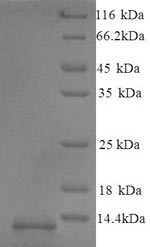Recombinant Mouse Guanylate cyclase activator 2B (Guca2b) is produced in a yeast expression system and contains the full length of the mature protein, spanning amino acids 22-106. The protein carries an N-terminal 6xHis tag for easier purification and detection. SDS-PAGE analysis shows purity exceeding 90%, which appears suitable for various research applications and may provide reliable, consistent results.
Guanylate cyclase activator 2B (Guca2b) plays a key role in regulating the guanylate cyclase signaling pathway. It's involved in controlling cyclic GMP production, which likely influences various physiological processes. This function in the pathway makes Guca2b an important research target for studying cellular signaling and regulatory mechanisms.
Potential Applications
Note: The applications listed below are based on what we know about this protein's biological functions, published research, and experience from experts in the field. However, we haven't fully tested all of these applications ourselves yet. We'd recommend running some preliminary tests first to make sure they work for your specific research goals.
Yeast systems can support proper folding and some post-translational modifications for eukaryotic proteins, but Guca2b may require specific conformational features for its role in activating guanylate cyclase. The His tag is small and may not significantly interfere with folding. Still, without experimental validation (e.g., activity assays), the protein cannot be assumed to be correctly folded or bioactive. The high purity reduces impurities but does not guarantee functional conformation.
1. Protein-Protein Interaction Studies via His-Tag Pull-Down Assays
The His tag enables pull-down assays to identify potential binding partners, but if Guca2b is misfolded, interactions may be non-physiological. Validate any identified partners using native Guca2b from mouse tissues or confirm with complementary methods like co-immunoprecipitation. The high purity minimizes background but does not ensure biologically relevant interactions without folding validation.
2. Antibody Development and Validation
This recombinant Guca2b is suitable as an immunogen for antibody production, as antibodies can recognize linear epitopes even if the protein is misfolded. The high purity supports consistent immunization. However, antibodies generated may not bind to native, correctly folded Guca2b in physiological contexts. Validate antibody specificity against endogenous Guca2b from mouse samples.
3. His-Tag Based ELISA Development
The His tag facilitates ELISA development by allowing immobilization on nickel-coated plates. However, if Guca2b is misfolded, the assay may not accurately quantify native Guca2b in biological samples. Validate the ELISA with native Guca2b standards to ensure it measures physiological forms reliably.
4. Biochemical Characterization and Stability Studies
This application is feasible for basic biophysical analysis (e.g., thermal stability, pH tolerance). The yeast expression may provide relevant modifications, but data may not fully reflect native Guca2b without activity validation. Use the protein for stability studies, but interpret results cautiously in the context of potential folding issues.
Final Recommendation & Action Plan
Before using this recombinant Guca2b for functional studies, validate its folding and bioactivity through a guanylate cyclase activation assay or binding studies with its receptor. If active, proceed with interaction or ELISA applications; if inactive, limit use to antibody production or biochemical characterization, but always validate outcomes with native Guca2b. For reliable results, consider comparing with Guca2b expressed in mammalian systems for critical functional assays.






